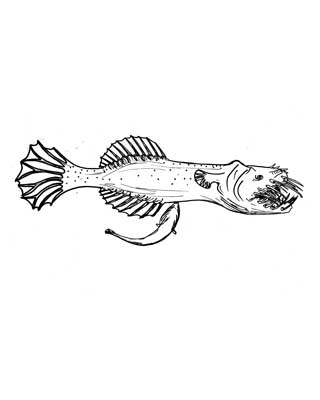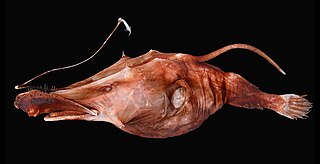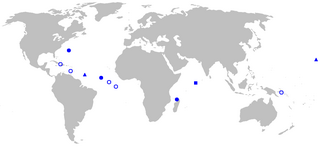
Leftvents are small, deep-sea lophiiform fish comprising the family Linophrynidae distributed throughout tropical to subtropical waters of all oceans.

The footballfish form a family, Himantolophidae, of globose, deep-sea anglerfishes found in tropical and subtropical waters of the Atlantic, Indian, and Pacific Ocean. The family contains about 22 species all in a single genus, Himantolophus.
This glossary of ichthyology is a list of definitions of terms and concepts used in ichthyology, the study of fishes.

The triplewart seadevil is a sea devil of the family Ceratiidae and the order Lophoiiformes. This species is the only member of its genus. Noted for its extreme sexual dimorphism, the triplewart seadevil's length ranges from 20 to 30 cm for females and 1 to 3 cm for males.

Haplophryne mollis, the ghostly seadevil or soft leftvent angler, is a species of anglerfish in the family Linophrynidae and is the only species in the genus Haplophryne. It is found in the bathypelagic and mesopelagic zones of tropical and subtropical parts of the world's oceans at depths down to about 2,250 m (7,400 ft).
Bertella idiomorpha is a species of deep-sea anglerfish found in the northern Pacific Ocean. It is the only species in the genus Bertella, in the family Oneirodidae, and can be distinguished from other members of the family by the structure of its hyomandibular bone.

The horned lantern fish or prickly seadevil is a deep-sea anglerfish found worldwide. It is the sole species in the family Centrophrynidae, distinguished from other deep-sea anglerfishes by various characters including four pectoral radials, an anterior spine on the subopercular bone, and a short hyoid (chin) barbel in both sexes.

The toothed seadevil, spiny seadevil or netbeard seadevil, (Neoceratias spinifer), is a rarely seen deep-sea anglerfish found in the mesopelagic and bathypelagic zones of the western central Pacific Ocean. It is the only species in the family Neoceratidae, and is unique amongst the deep-sea anglerfish in lacking an illicium and esca, and in having large teeth placed on the outside of its jaws.

Phyllorhinichthys is a genus of dreamers. Like other oneirodids, they are small, bathypelagic fish with bioluminescent lures. Phyllorhinichthys is unique amongst the deep-sea anglerfish in having a pair of fleshy, leaf-like structures on its snout.
Prince Axel's wonder-fish is a bottom-dwelling deep-sea anglerfish of the family Thaumatichthyidae. Thaumatichthys axeli lives at a depth of around 3,600 meters, deeper than any other member of the genus Thaumatichthys. As with other members of the family, they possess a distinctive forked light organ inside their mouth, which they use to lure prey. Large, curved teeth "fringe the upper jaw like a comb". Specimens have been founding measuring up to about 50 cm.

Thaumatichthys binghami is a species of wolftrap angler known from the western central Atlantic Ocean, where it occurs at a depth of 2,532 metres (8,307 ft). This species is similar to T. axeli, except that its esca bears 2–3 pairs of lateral lobes that are elongated into tapering filaments in the largest individuals, and the uppermost medial appendage on the esca is finger-like and tapering.

Lasiognathus is a genus of deep-sea anglerfish in the family Thaumatichthyidae, with six species known from the Atlantic and Pacific Oceans. It has been called a "compleat angler", in that its lure apparatus appears to consist of a fishing rod, a fishing line, bait, and hooks. It is also distinctive for an enormous upper jaw with premaxillaries that can be folded down to enclose the much shorter lower jaw.

The redeye gaper, Chaunax stigmaeus, is a sedentary species of anglerfish in the family Chaunacidae. It is native to deep waters in the western North Atlantic from the Georges Bank off New England southward to the Blake Plateau off South Carolina. The species is found on the outer continental shelf and upper continental slope at a depth of 90–730 m and among dense beds of dead coral rubble, their preferred habitat. The original type specimen was caught in a trawl off Atlantic City on March 1, 1946, and donated to the Academy of Natural Sciences by Carroll B. Atkinson. The name stigmaeus means "speckled" in Greek.

The anglerfish are fish of the teleost order Lophiiformes. They are bony fish named for their characteristic mode of predation, in which a modified luminescent fin ray acts as a lure for other fish. The luminescence comes from symbiotic bacteria, which are thought to be acquired from seawater, that dwell in and around the sea.

Black seadevils are small, deepsea lophiiform fishes of the family Melanocetidae. The five known species are all within the genus Melanocetus. They are found in tropical to temperate waters of the Atlantic, Indian, and Pacific Oceans, with one species known only from the Ross Sea.

The humpback anglerfish is a species of black seadevils in the family of Melanocetidae, which means "black whale" in Greek. The species is named after James Yate Johnson, the English naturalist who discovered the first specimen in Madeira in 1863. The common names include anglerfish, viperfish and fangtoothfish.

Rhynchactis is a genus of deep-sea anglerfish in the family Gigantactinidae, containing three species found worldwide at depths greater than 400 m (1,300 ft). Adult female Rhynchactis reach a standard length (SL) of 11–13 cm (4.3–5.1 in) and have a dark-colored, streamlined body and a relatively small head bearing a very long illicium. Unlike almost all other deep-sea anglerfishes, the illicium bears no bioluminescent esca at the tip. The mouth is almost devoid of teeth, and the inside of both jaws are covered by numerous white glands that are unique to this genus.

Borophryne apogon, the netdevil, or greedy seadevil, is a species of leftvent anglerfish known today from the waters of the eastern Pacific Ocean off the Central American coast. It is found at depths down to around 1,750 m (5,700 ft). This species grows to a length of 8.3 centimetres (3.3 in) TL. A fossil specimen of this species has been found in the Los Angeles Basin dating back to the Late Miocene, some eight million years ago.

Linophryne indica, or headlight angler, is a leftvent anglerfish in the family Linophrynidae, found in the bathyal zone of the Pacific Ocean at depths below 1,000 m (3,300 ft). The female is significantly larger than the mature male. A fossil specimen of this species has been found in the Los Angeles Basin dating back to the Late Miocene, some eight million years ago.

Melanocetus murrayi, commonly known as Murray's abyssal anglerfish, is a deep sea anglerfish in the family Melanocetidae, found in tropical to temperate parts of the world's oceans at depths down to over 2,000 m (6,600 ft). Its length is up to 13.5 cm (5 in) for females and up to 2.8 cm (1.1 in) for males.

















